|
|
|
|||
ProFile: Harold Martinby Chris Martin |
||||
At the July IHRA CARQUEST Empire Nationals in Leicester, New York, one Harold Martin qualified for Pro Modified eliminator on the bubble with a 6.491/217.44. He had to fight hard to get into the show with previous efforts of 6.64/205.91 and 6.53/215.48 getting bumped out. His final effort put him in the 16th slot but unfortunately against the No. 1 qualifier Fred Hahn in Jim Oddy’s ‘53 Corvette. Martin tried hard with a first-round 6.55, but Hahn cranked out a record 6.26 to put him on the trailer.
For one thing, Martin is just about the only black racer of renown in IHRA Pro competition. The NHRA has former NBA basketball players Larry Nance and Tom Hammonds belted into Pro Stocks, but that’s just about it. Since 1976, Martin of Southfield, Michigan has been knocking around doorslammer pits, running in NHRA, AHRA, and IHRA Pro Stock and IHRA Pro Modified Eliminators, not to mention the Great Lakes area match race circuit. However, while Martin may be the only black racer to crash into the country club in IHRA, he has accomplished something that no other drag racer has ever done. He is the ONLY racer in either association to have ten world mechanical patents to his name. Most of you who are subjected to the constant bombardment of car dealership TV and radio ads are familiar with the term "electronic fuel injection." Would you believe, as comedian Don Adams (Maxwell Smart of "Get Smart" fame) might say, that Martin was a member of the General Motors engineering team that came up with the device?
From 1980 through 1995, Martin worked at General Motors, mostly in the electronic engineering department, and it was there that he made his corporate mark. Like most in the vanguard of something different, Martin’s ascendency to mechanical prowess was not a straight line affair. As he tells it, there was little doubt that he would be involved in something mechanical during his tenure on earth, but what it was didn’t develop until his teens.
"My father, Houston, bracket raced all around Michigan, especially at Detroit Dragway," Martin recalled. "I was like a lot of kids with a father like that. I was interested in cars, and my travels took me from the street race scenes on Woodward and Stecker Avenues to the drag strip. However, as much as I liked the idea of driving, I was motivated more by the mechanical end of things. "Being a competitive person, I also wanted to make a significant contribution. Not just be a face in the crowd, but make an impact, so I never missed an opportunity to learn. My area of interest was the internal combustion engine." Predictably after Martin graduated form Mumford High in Detroit, he moved on to Oakland University in 1978 just north of the motor city and majored in automotive engineering. At the same time, he started hanging at the factories, and landed himself a job for co-op students on the Detroit Diesel assembly line. Shortly thereafter, he moved on to Cadillac’s engine plant. Martin couldn’t get enough of the General Motors facilities. His days started at 8 a.m. and were scheduled to end at 4 p.m.. but he always would seek out some department afterwards and volunteer to help out in exchange for learning something. He seldom left the plants before 8 p.m. "I was really into it," he said, "but it wasn’t always easy. I struggled on the social front, as well as with whatever technological thing I was grappling with. Being black, I knew that you really had to work at fitting in, that people really checked you out. There were cliques and inner circles, and naturally — and I learned this from drag racing — no one was volunteering to rush forward with secrets." "I had friends in my old neighborhood, but I wasn’t really into hanging out and making the nightclub scene. It wasn’t that I didn’t enjoy it, but I had other things that really grabbed me. I know some of my girlfriends would complain, ‘You’re more interested in your cars than you are me,’ and I’ll be doggone if they weren’t right. I guess you could say I was like that guy in the song, Mr. In-Between."
In 1980, though, he almost pulled out of drag racing completely. General Motors had noted his desire and talents and asked if he would like to be involved in the production of a GM electronic fuel injection system. Given that this was where his real interests lay, Martin didn’t park his racing operation, but only appeared sporadically on race tracks while he pursued his automotive career. In the 15 years that followed, Martin scorched the pavement in that tech department. Being the newest member of a four-man engineering department, Martin went to work to show his mettle. "The first thing I was to develop was a wire harness for the fuel injection system," he said. "Basically, it involved actually wiring the unit. I was intimidated at first by all the high-level tech jargon, but I knew I could come up with something. We developed the unit in a six-month program." From there, Martin played a leading role in several automotive engine and control systems for GM such as traction control devices (traction controlled through the engine) and an electronic spark delivery system. He also produced a unit that provided heavy load engine protection, a device in which the engine could actually run without water and protect itself. In 1995, Martin graduated again; this time from General Motors, and realistically only in a matter of speaking.
Given the distance he’s come, Martin looks like he’ll warrant a lot of attention in the coming years.
Photos by Jeff Burk and Rollo Tomassi
|
||||
|
Copyright 1999-2001, Drag Racing Online and Racing Net Source |
||||

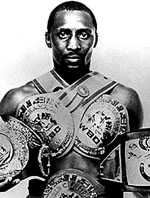 Some fans may have notice
a very famous sports name on the rear quarter panels of Harold
Martin’s AC-Delco Pontiac: one Thomas "the Hit Man"
Hearns. For those race fans who are up on pro boxing, Hearns
is one of today’s fighters who is guaranteed a spot in
the Boxing Hall of Fame in Canastoga, New York. Hearns currently
is the only fighter in history who has won world championships
in six different weight divisions. He was, at one time or another,
the WBA Welterweight (147 lbs), WBC Light-Middleweight (154
lbs) WBC Middleweight (160 lbs), WBO Super-Middleweight (168
lbs), WBA Light-Heavyweight (175 lbs), and just this year he
beat Nate "Mister" Miller for the IBO Cruiserweight
World Championship (190 lbs) at age 40. He is also a two-time
Ring Magazine Fighter of the Year and his first fight with "Sugar
Ray" Leonard in 1981 and his 1985 duel with Marvelous Marvin
Hagler were voted Ring Magazine’s Fight of the Year. A
bad dude, indeed, but as it turns out a great fan and good friend
of Harold Martin.
Some fans may have notice
a very famous sports name on the rear quarter panels of Harold
Martin’s AC-Delco Pontiac: one Thomas "the Hit Man"
Hearns. For those race fans who are up on pro boxing, Hearns
is one of today’s fighters who is guaranteed a spot in
the Boxing Hall of Fame in Canastoga, New York. Hearns currently
is the only fighter in history who has won world championships
in six different weight divisions. He was, at one time or another,
the WBA Welterweight (147 lbs), WBC Light-Middleweight (154
lbs) WBC Middleweight (160 lbs), WBO Super-Middleweight (168
lbs), WBA Light-Heavyweight (175 lbs), and just this year he
beat Nate "Mister" Miller for the IBO Cruiserweight
World Championship (190 lbs) at age 40. He is also a two-time
Ring Magazine Fighter of the Year and his first fight with "Sugar
Ray" Leonard in 1981 and his 1985 duel with Marvelous Marvin
Hagler were voted Ring Magazine’s Fight of the Year. A
bad dude, indeed, but as it turns out a great fan and good friend
of Harold Martin.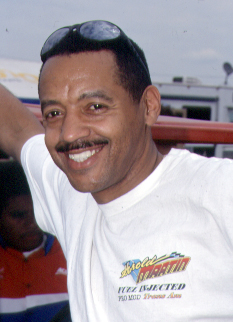
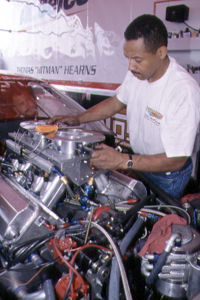 Electronic
fuel injection systems are as common as house flies on the car lots
of America, and if Martin has his way, they may be that way in both
Pro Stock and Pro Modified.
Electronic
fuel injection systems are as common as house flies on the car lots
of America, and if Martin has his way, they may be that way in both
Pro Stock and Pro Modified.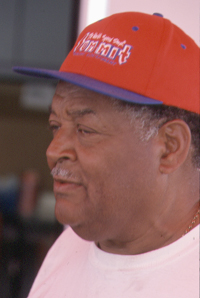
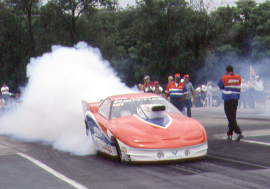 While
Martin was building his one career, he was also working on another,
although it was probably not getting the attention his technical side
did. In 1976, he started racing the "Little Kim" Camaro in
Pro Stock action at Detroit Dragway. Having limited funds and time,
he didn’t figure in the national picture. However, he got better
as time went on, running his first 8-second time (an 8.92) at the 1978
NHRA Little Guy National Open in Suffolk, VA.
While
Martin was building his one career, he was also working on another,
although it was probably not getting the attention his technical side
did. In 1976, he started racing the "Little Kim" Camaro in
Pro Stock action at Detroit Dragway. Having limited funds and time,
he didn’t figure in the national picture. However, he got better
as time went on, running his first 8-second time (an 8.92) at the 1978
NHRA Little Guy National Open in Suffolk, VA.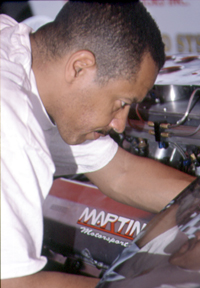 "I
decided to quit to become a pro racer and create Martin Motorsports,"
he said. "In addition, I wanted to create a market for electronic
fuel injection systems for performance cars of all types. It’s
turned out pretty well because GM has contracted me to develop these
systems for more future GM performance aftermarket programs. One of
my clients, Danny Scott, has one of the fastest Pro Street cars in the
country with our fuel injection systems for performance cars of all
types. It’s turned out pretty well because GM has contracted me
to develop these systems for more future GM performance aftermarket
programs. One of my clients, Danny Scott, has one of the fastest Pro
Street cars in the country with our fuel injection system, and my AC-Delco
Pontiac Firebird uses one and has a best of 6.44/217 to its credit.
"I
decided to quit to become a pro racer and create Martin Motorsports,"
he said. "In addition, I wanted to create a market for electronic
fuel injection systems for performance cars of all types. It’s
turned out pretty well because GM has contracted me to develop these
systems for more future GM performance aftermarket programs. One of
my clients, Danny Scott, has one of the fastest Pro Street cars in the
country with our fuel injection systems for performance cars of all
types. It’s turned out pretty well because GM has contracted me
to develop these systems for more future GM performance aftermarket
programs. One of my clients, Danny Scott, has one of the fastest Pro
Street cars in the country with our fuel injection system, and my AC-Delco
Pontiac Firebird uses one and has a best of 6.44/217 to its credit. "I’m
going to develop this product through drag racing. I have obligations
as a husband and father. I’ve got my wife Allison and nine-year-old
Harold Michael II, along with my dad as part of the team, and they’ve
really motivated me to try and become the IHRA Pro Modified World Champ.
I’m goal-oriented and that’s what I’ll be working at
now that I have more time to race."
"I’m
going to develop this product through drag racing. I have obligations
as a husband and father. I’ve got my wife Allison and nine-year-old
Harold Michael II, along with my dad as part of the team, and they’ve
really motivated me to try and become the IHRA Pro Modified World Champ.
I’m goal-oriented and that’s what I’ll be working at
now that I have more time to race."